Family News - 2010 July 14th
Contents
- A word from the Superior General
- Fr Etchecopar wrote...
- Year for Priests: Conclusion and Thanksgiving
- The One who saves from the Waters (2)
- Poem to Our Lady of the Beautiful Branch
- He who sings prays twice
- 5 minutes with Father Valan Kanagaraj
- In memoriam: + Fr. José Antonio da Silva
- The experience of Betharram in China (7)
| format PDF |
A word from the Superior General

For the glory of the Father who is in Heaven
Today a lot of the youth attach great importance to the religious habit. Without wanting to enter into the debate, I am convinced that the real visibility of our consecrated life lies in the joyous witness that we give by living according to the Gospel, both in our private as in our public life. The joy of the faith and of charity, the joy of being a man of God and a fraternal man, the joy of forgiveness and of a simple life, the joy of presence and the generosity of devotion toward those who have been entrusted to us, the joy of having responsibilities and of spending ones self in labour, the joy of tolerance and of respect of differences, the joy of humility and goodness.
We didnt choose this form of life simply to show off. Our choice is rooted in our experience of Gods love; in reply to this love we decided to make of our lives an act of love for God and for our brothers, the whole humanity which he loves. Such a basic direction with everything which it embraces in renouncement and devotedness, gives meaning and joy to our lives. We lead our evangelical life style, whether people can see us or not, whether they are remotely interested in what makes our life, whether our choice of life disturbs or not, whether we are respected, criticised, or persecuted , as we were warned by Jesus, our only Lord and Master, who was persecuted too.
The value of our life depends on the fidelity, the coherence, the authenticity, the steadfastness and the humility to be what we are. If I go into a church to pay a visit to the Blessed Sacrament, even if the church is empty, I dont stay there waiting for someone to see me. I am faithful to my vow of chastity because I regard it as an evangelical value as a fulfilment for me even if it is the object of mockery for the neighbours. I remain chaste even alone in front of my computer. I maintain good relations with someone who has humiliated me in public one day, even if others in my place would have sought revenge, because I am convinced that he who offended me is my brother, son of the same Father.
Visibility of our Christian life is essential for our mission: No one lights a lamp to put it under a tub; they put it on the lamp stand so that it shines for everyone in the house. In the same way your light must shine in the sight of men, so that, seeing your good works, they may give praise to your Father in Heaven. (Matt 5, 15-16)
There is a form of visibility which is sometimes neglected: it is when people see us living differently from what we profess. For me, I like wearing the habit, but not to bear witness to Christ but so that others will have a good opinion of me. I prefer to go unnoticed, not to attract attention, to be discreet so as to be able to go anywhere without people knowing who I am. We claim to be religious, we proclaim the preferential option for the poor yet the car we drive tells people that we are not poor. People regard us as religious because we are in a parish or a college, but they are shocked at seeing us return to the community late at night, maybe the worse for drink. They hear us constantly talking about money, taking great sermons from books, but they have never come across us in prayer before the tabernacle, or talking with passion about Jesus Christ and the things of the Spirit. People know that we are obliged to live in community, yet I notice that there is a brother who is always outside, that he never misses a trip, something which a married man could not do. That too is a visible element of our religious life, and it is something which is much more eloquent that wearing the cassock or the Roman collar which we put on for a ceremony or to pay a visit to the sick in the parish.
That is what is known as hypocrisy, the contradiction between what we profess and how we live. It is something which does a lot of harm to our life and our mission, and it is a stumbling block for the young: it turns them away from us, instead of attracting them. We dont realise that according as our behaviour is modelled on the customs of the world in which we live, we have turned away from the evangelical criteria, we have forgotten Jesus Christ, the God of Love, and we have lost the enthusiasm which made our life a joyful occasion.
Jesus has provided us with the where withal for an examination of consciousness: Alas for you, scribes and Pharisees, you hypocrites! You who shut up the kingdom of heaven in mens face neither going in yourselves nor allowing others to go in who want to. Alas for you, scribes and Pharisees, you hypocrites! You who travel over sea and land to make a single proselyte, and when you have him you make him twice as fit for hell as you are... You blind guides! Straining out gnats and swallowing camels! Alas for you, scribes and Pharisees, you hypocrites! You who clean the outside of cup and dish and leave the inside full of extortion and intemperance! (Matt 23, 13 25)
During a visit to some communities, a young man of about 22 years of age, who was taking part in a reflexion group on our charisma, came to meet me. This is how he explained his situation to me: Father, I want to discern my vocation; I very much like the Betharram charisma, but I also like the spirituality of a movement of which I am a member with my parents. In this particular movement I like the life style of the religious, but I dont like the life style of the Betharram religious. You can imagine my sadness when I told him to pray and to get help with his discernment, not so much in what he likes as in what God wants for him. I have since learned that this young man has entered with the religious whose life style attracted him. Our life speaks for itself. Our behaviour reflects the real motivations which are ours, the interior and exterior are linked, as St Michael Garicoits would say.
Gaspar Fernandez,SCJ
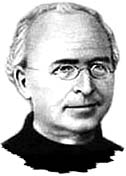 Fr Auguste Etchecopar wrote...
Fr Auguste Etchecopar wrote...
Entry in his personal diary No 38 (1854)
Yes, I have no doubts about it: the priesthood is something so sublime, so divine that the Priest should be another Jesus Christ
My Saviour, what a wretched representative you have here! What a poor, imperfect and defaced copy! A copy which is hardly recognizable in comparison with the admirable example of your holiness, O my God, of your perfections, O Jesus. And yet all things are possible, for I can do all things in him who is my strength (Phil 2,13). You can change stones into children for Abraham. Oh Lord, fill me with your spirit. If the Spirit of him who raised Jesus from the dead, lives in me, he will also instil life into my mortal body. (cf. Rom. 8,11). Revive in me and increase the spirit of strength and of grace which you bestowed on me in my ordination. Grant that I may correspond to your grace and put all my trust in Our Lady, your Mother.
Oh Jesus, I hope in you! O Jesus, I want to be pleasing to you! O Jesus, how good you are! I want to praise you for all eternity.
Year for Priests
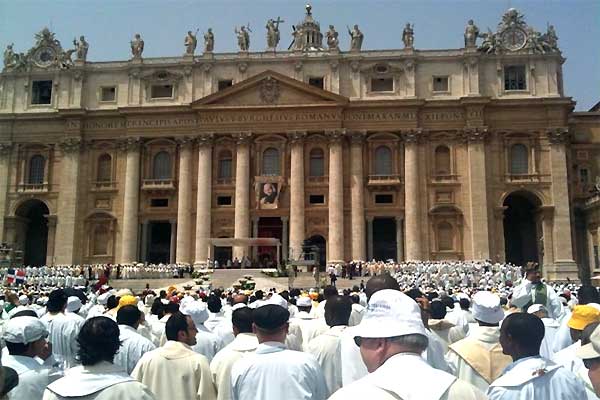
Conclusion and Thanksgiving
For the closing of the Year for Priests, I was present at the meeting of the priests in Rome, with the Pope. I was happy to hear the witness of Cardinal Marc Ouellet, Archbishop of Quebec. He told us how, after his ordination as priest after the Council, he began his ministry during turbulent times for the Church; and how he got through them by giving priority to the Word of God, to the love of prayer and care for the poor.
Joyfully I heard what Benedict XVI said in his sermon for the Feast of the Sacred Heart: to be a priest is not for personal glory but it is a gift from God to be received with gratitude, and with much humility.
With deep intensity I participated in adoration of the Blessed Sacrament during Thursday night and was impressed by the deep silence on St Paters Square. There was a priest from Brazil beside me: during the Popes sermon he kept on nodding his head as a sign of approval. In front of me was a woman from Brazil trying to kneel on the paving slabs but she couldnt hold it for long as her knee was hurting her; she would kneel, then sit and finally kneel again. A bit further on was an African woman who was praying with such fervour that she spread an atmosphere of prayer around her. Next came the witness given by some priests: from Ars the actual Paris Priest; from Buenos Aires, a priest from Barracas; from Jerusalem an auxiliary bishop who had only just been consecrated and who was speaking as from the Cenacle where Jesus made us the gift of the Priesthood.
In Central Africa we have a very special ecclesiastical situation. This requires of us missionary priests to rediscover what the mission is all about with the local clergy, so that the idea of us and you no longer exists. How are we to announce the Good News without opposition or division: here is a whole area of communion for each one of us.
In Rome I witnessed the links woven between the communities in via Brunetti and the church of Miracles, not forgetting a delightful visit to the Villa del Pino (Monteporzio) which is helping us in receiving and caring for HIV patients in our new St Michael de Bouar Centre.
In Rome I caught up with Fathers I hadnt seen for years!
On 11th June we celebrated the Feast of the Sacred heard. On 12th June 1965 I was ordained in Milan with four others. What does the Heart of Christ mean for the priest of the Sacred Heart that I am? These days I have been reading in the NEF (14th May 2010) the account of Fr Athanase who was annoyed that Fr Garicoits should be helping him to empty the barrel. The humility to which Benedict XVI is inviting us is the same humility of the Heart of Christ portrayed by St Michaels Manifesto.
Mario Zappa, SCJ
Our Lady of Miracles | Our Lady of Betharram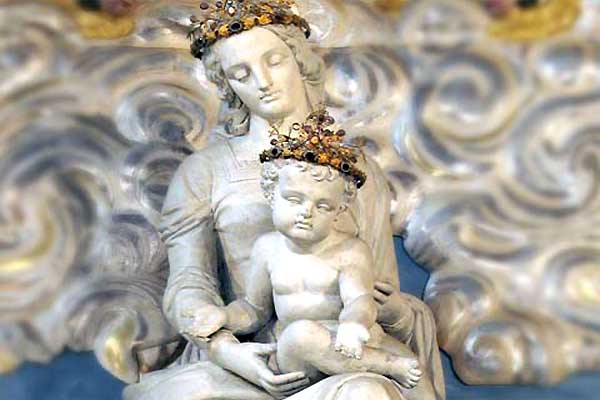
The One who saves from the Waters (2)
In the 1940s the liturgical feast of Our Lady of Betharram was instituted and appointed to be kept on the 28th July; on this same day in 1912, Mgr Francois Gieure, Bishop of Bayonne, had crowned the statue of Our Lady and of her child with the crowns offered by Pope Pius X and brought back from Rome by Fr Victor Bourdenne, General procurer of the Congregation, in the presence of 10 Bishops, 600 priests and 30.000 pilgrims.
Our Lady of Miracles is connected with another story which is well worth telling. Many of those who visit the shrine in Rome pray before a magnificent white statue in a side chapel. It is the statue of Our Lady of Betharram, a copy of the original which is kept in France, in the sanctuary of Betharram, entrusted to the Sacred Heart Priests.
In the Bearn, a place called Betharram is a very old sanctuary to Our Lady. Close by flows the river Gave which flows past the Lourdes grotto, a bit further up. The history attached to these places is as old as the hills.
Not far away, more than 500 years ago, a young girl was gathering flowers on the banks of the river river which was deep and swirling. Suddenly in order to enhance her bouquet she reached for a beautiful flower with a lovely perfume. She advanced too far on the river edge and her feet slid on the wet grass. In an instant she was swept away by the current; there was nobody around to hear her cries for help. But her faith was stronger than her fears. She called on the Blessed Virgin and immediately an unexpected branch appeared on the surface of the water, just in time to offer a priceless help. The branch was guided along by a kind and invisible force; the young girl clung to it and was pulled on to the bank. As a sign of her gratitude she had a branch made in gold by an expert goldsmith and presented it to the Virgin of the Sanctuary. And so for centuries the Madonna is venerated here under the invocation of Our Lady of the Lovely Branch, beth-arram in Bearnais.
By popular devotion she has been proclaimed protector of young girls and five centuries of great graces are proof that the Mother of God is pleased with the title. The river, with its many traps and dangers is an image of the great river of life, along which flow the hustle and bustle of misfortunes and temptations.
Pope St Pius X was very attached to Our Lady of Betharram so much so that he offered her two magnificent golden crowns, ressembling woven branches. This offering was accompanied by an inscription: May the Son and his Mother accept our gifts and by appeasing our hopes and desires may they keep for us one day the crown of glory which none can tarnish.
It was this same Pius X who entrusted to the Betharram Fathers the church of Our Lady of Miracles together with the adjoining premises. Up to then the Fathers had been entrusted with the church of the Guardian Angels in the Triton and which was then demolished. Since 1915 they are at the service of the church Place du Peuple, thus confirming the spiritual twinning of the Roman sanctuary with the sanctuary in the Pyrenees.
Giuseppina Sciascia
"Madre di Dio", July 1990
As for Betharram, the foundation in Rome was due to the necessity of having a foot hold here, principally to speed up the cause of canonisation of Fr Michael Garicoits and to be able to give hospitality to the Fathers who were studying. Thanks to the efforts of Fr Saubat, by August 1904 the General Council was able to take a look at the suggested Church of the Guardian Angels, which was being refurbished and was without a chaplain. After months of discussions and maintenance, on 2nd October 1905, the church of the Guardian Angels was reopened to the public, in the presence of the Superior General, Fr Bourdenne, of the Secretary of State, Cardinal Merry del Val, and other church dignitaries. The first Superior and Procurer was Fr Fargues. The Church of the Guardian Angels was demolished by the city Council at the end of 1916 to allow for expansion. However, the presence of the Betharramites in the Eternal City continued in the church of Our Lady of Miracles, Place du Peuple. (R. Cornara, archivist)
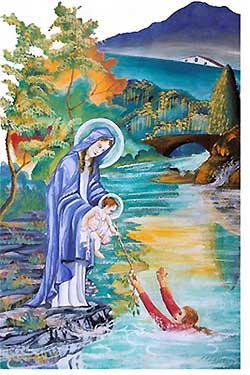
POEM TO OUR LADY OF THE BEAUTIFUL BRANCH
O Mother, fount of all tenderness
You who hasten to get us out of our distress
In the face of our struggles and our misfortunes
To offer us your Beautiful Branch.
Even when hell imposes its misery on us
You, our Mother, you stay close to us
You drive far from us all that is evil and all that is false
As you offer us your Beautiful Branch.
When our heart is heavy on the path of despair
You open our eyes so that we grab the branch of hope
And you lead us along a new path
As you offer us your Beautiful Branch.
Dont let the evil of sin make us deaf
Keep us attentive to your loving voice
As we get out of the deep waters
We shall sing for you, Our Lady of the Beautiful Branch!
Jean-Paul Kissi (novice, Vicariate of Ivory Coast)
CD: FROM MICHAEL TO MIRIAM
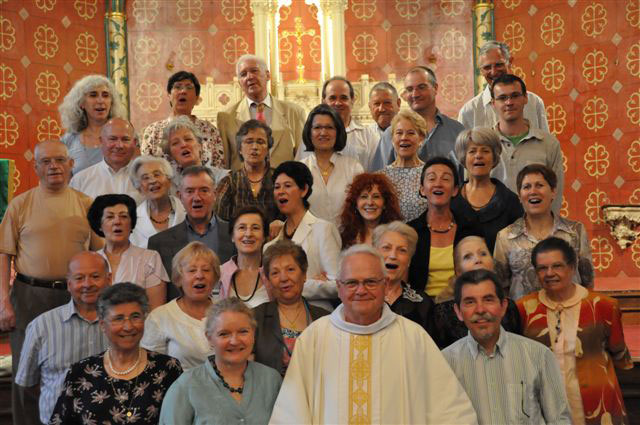
He who sings prays twice
On 21st May, the eve of Pentecost, there appeared a CD with a collection of hymns dedicated to St Michael Garicoits, to Blessed Miriam and to Our Lady. To mark the occasion we are here publishing the introduction by the Fathers of the community in Pau.
St Michael Garicoits was the founder of the Religious Congregation of Betharram. He died in Betharram in 1863. To sing for Michael Garicoits is singing the Love of the Heart of Jesus for the whole of mankind, it means adopting his motto Here I am without delay, without reservations, without backward looking, and for love.
Blessed Marie of Jesus Crucified, Miriam, the young Arab is a Carmelite from Jesus homeland, her native Galilee. She died in 1878 in Bethlehem. To sing for her is to sing the marvellous deeds wrought in her by God. The more the Believer is seized by God the more God will make himself known to him in the most extraordinary manner; with Miriam everything is exceptional.
To sing for Our Lady of Betharram (The Virgin of the Beautiful Branch) means praising the action of God in the heart of Mary as he was preparing her to be the Mother of God and Mother of the Church. To sing for her means grabbing the branch which she is offering us , just as she offered it to the little girl who was being swept away by the waters of the river at Betharram. The vicissitudes of life threaten to sweep us along, but lets grab her beautiful branch...
To sing the Mass of the Holy Spirit in St Michaels in Pau is to remember the vow of our Blessed Miriam! Well before Vatican II which insisted a lot on the place of the Holy Spirit in the Churchs prayer, Miriam had already recalled this evangelical need. Lets sing to the Holy Spirit who guides and enlightens his Church.
The singers are the St Michaels Little Choral On the second Tuesday of every month they sing the Mass of the Holy Spirit at 19h00 in the Chapel of St Michaels House which used to be a the Carmelite monastery of Pau where Blessed Miriam spent many years. They sing the Solemn Mass on the feast day of Blessed Mary of Jesus Crucified, which is celebrated on the Saturday nearest the 24th May. They sing... they sing... they sing...
The Fathers of "Maison Saint-Michel" (Pau)
 To order the album, From Michael Garicoits to Blessed Miriam, 24 tracks of hymns and organ music (15) contact: petitchoeur.saintmichel@orange.fr
To order the album, From Michael Garicoits to Blessed Miriam, 24 tracks of hymns and organ music (15) contact: petitchoeur.saintmichel@orange.fr
5 minutes with.. Father Valan Kanagaraj
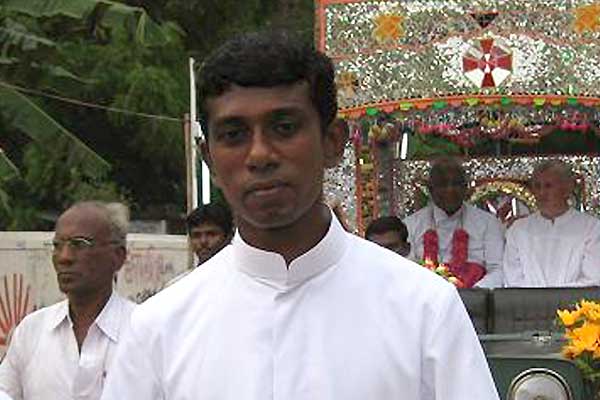
India is the youngest and most dynamic Vicariate of the Congregation, in terms of vocations. Last May, three new priests were ordained there Betharram: Fr Subesh Odiyathingal 8, P. P. Valan Kanagaraj 14, and P. John Britto Irudhayam 16. Meeting with the just ordained in Saint Michael Garicoits' Day.
Nef: Fr. Valan how do you feel today? What has the ordination changed in your life?
- I feel happy for God being mercy upon me. B) Ordination is only a blessing g iven by God to be a minister and a mediator between God and His people. Therefore, it has nothing to change but only name from Brother to Father (Just joking). Because what I cannot change during the 13 years of my formation cannot be changed by Ordination. I wish and pray that I remain a Holy Priest.
What examples, in your family or by the priests you have met, awakened your vocation?
- To be frank I had no one as an example who awakened my vocation but a gentle man called Michael Garicoits and his spirituality and I wanted to be more like him in my availability.
What has brought you to knock at the door of the congregation?
- To tell the truth, I did not know the differences between diocese and congregation before I joined the seminary. Thanks be to God who has called me to be in this family of Betnarram,and I proud to be a Betharramite. B) Shared sorrow half the sorrow and shared happiness doubles the happiness, therefore, give the same happiness to others that I enjoy in the Lord.
You entered Betharram 13 years ago. how do you look back at these past years of formation?
- Happy and contented. Priestly life is a on going process. if it gets stagnant by ordination it only will get smell but if I continue my on going process I can be a beautiful instrument in the hands of God.
During your regency in the diocese of Bidar, what did you learn about the mission and the people you been sent?
Total availability, commitment and whole hearted dedication is what I learned to do mission in Bidar. People in Bidar, whom I came in contact with, are so loving and hospitable even in their poverty.
In what consist your ministry now?
- I am appointed as assistant parish priest of St Joseph's Church, Adigondanahally, Bangalore, where Fr Antony Britto is the parish priest. B) It's challenging but I hope with prayers and support of our congregation I will do well.
In your opinion, what are the challenges in India, in 2010, for a religious priest?
- In my opinion, as a religious priest I need to challenge my self to give an exemplary life. It is easy to quote some one as an example. I need to ask myself, How can I be a quote to others? That's challenging.
St. Michael dreamt of forming flying camps at the disposal of the Church and attentive to people. Do you any project for the present, and any for future?
- My project is always the project of the family that I belong to. Work harder for the glory of God is what my present project. If God wish I would like to work for the Eunuchs in future.
God bless you all.
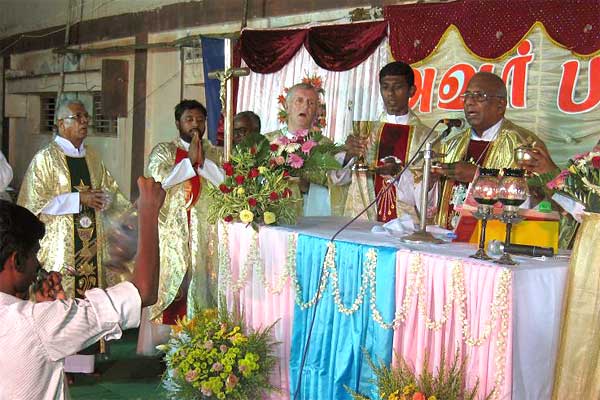
In memoriam | Brazil: FR. JOSE ANTONIO DA SILVA, SCJ
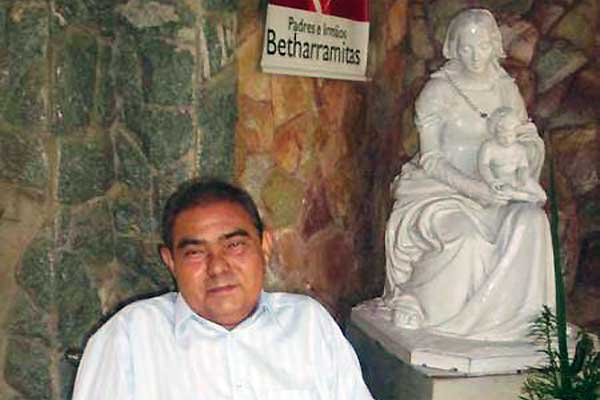
Jaboticatubas, 19th April 1956 | Belo Horizonte, 2nd July 2010
Fr Jose Antonio da Silva was born in the parish of Santana do Riacho (Jaboticatubas, State of Minas Gerais), on April 19th 1956. He made his first profession in Paulinia on January 22nd 1986, and was ordained a priest on November 30th 1991. He later lived in the communities of Conceiçao do RioVerde (1992), Douradina (1993-1996), Belo Horizonte (1997-1999 as parish priest), Passa Quatro (2000-2003) and Belo Horizonte (2004-2010).
A legendary character has left us! For more than the 20 years he spent in the Congregation he has left an indelible mark on each one of us. Truly Betharramite in his way of life, we can pick out three authentic characteristics of this vocation: the Cross, service and simplicity.
Disciple of Jesus Christ, Jose learned at an early age to shoulder the CROSS , following the example of his Master: the cross of work: at the age of seven he learned to cook; at the age of ten he was employed with his neighbours to give the services suitable to his age; from 14 to 17 years of age he found an employer, a wholesaler, who didnt go easy on the teenager, inflicting excessive work patterns, especially obliging him to load and unload sacks of cereals, weighing up to 60 kilos. He bore the consequences in his flesh for his growth was stumped and his bodily frame changed in such a way that one shoulder was higher than the other... At 17 years of ages he entered the service of a restaurant owner in Santa Luiza, whose restaurant was in St John the Baptist Parish. He worked there for a few years until he entered the Congregation; he had even been promoted to top of his group. The Cross of his vocation: Jose didnt chose to do as the young man in the Gospel; at 25 years of age he sold all he had, that is his commercial business, and gave the money to the poor; in this case to his mother whom he was leaving all alone; then he entered the nearby Betharramite community; it took some courage to get down to studying for up till then he had only done 4 years of primary schooling and even then in bits and pieces. The Cross of suffering: for years he had been undergoing medical treatment; little by little his body was deteriorating leading to the slow agony which preceded his death, the whole supported with a smile, good humour, without ever a word of complaint.
Jose was a man of SERVICE and of fraternity. In community he could welcome his confreres, often showing this by the quality of his cooking; during his years in the seminary he would make up for the shortages with this quality! Outside the community, and during his pastoral duties, he easily made contact with people and maintained links with all. It was interesting to see how the young were attracted to him, who had had no youth himself.
It is easy to see that SIMPLICITY formed part of the qualities that were his. Contrary to what might have been the case he never regarded his consecrated life or his priesthood as a form of social advancement. On the contrary, for him it was a form a further disponibility. He was a man of dialogue, able to listen to the simplest of people. He didnt engage in theoretical conversations but established contact by swapping recipes, or news about medicinal plants, and in this way reached the hearts of the people. He could identify with the most forgotten, especially with those of Afro origin, even taking part in their festivities. At their last annual celebration, in October 2009, he was crowned king of their Congo! One of the last joys he had here below was to have taken part in the celebration of Congado in the seminary.
Can we pray to him? He may not have been a regular modal of holiness, but the Gospel tells us Happy the pure of heart, for they shall see God. Jose Antonio was certainly PURE OF HEART.
José Mirande,SCJ
 |
7. COMMUNISM AND THE MISSION IN TALI (From December 1950 to December 1951)by |
The Communists had settled into Yunnan by December 1949. The first Red government was composed of locals who over the years had been won over to the Communist doctrine and duly indoctrinated and trained in the methods of the Party in the schools of Kien-Tchouang, situated a 100 KM to the north of Tali.
Their first contacts with the Mission were polite and even abounding in words of admiration for the work of the Missionaries which was both disinterested and for the benefit of the people. But a month later, the true face of the new government began to appear: the Mission was stripped of the only radio it possessed, as well as of the hunting guns and other small arms from the Tali resistance. The reason? We were to entrust to the Police, newly established, our protection which for the future would be guaranteed by the new China.
By the end of January, the boxes of medication which had arrived from Kunming for us, were hijacked towards the peoples hospitals. For, as we were told by the super mandarin from Tali this medication destined for the people could just as easily be distributed by them as by us. The missionaries who had come to the Mission for their annual retreat were only able to return to their district after obtaining the necessary travel visas.
This brings us up to December 1950.
Restrictions applied to the apostolate and the dwelling conditions of the Missionaries. In the afternoon of December 24th practically all the Missionaries of the Yunnan were to receive at the same time a notice from the local authorities limiting the their missionary activity to their place of residence and on a perimeter including the town and village, the centre of their district; to go anywhere else required a visa delivered by the authorities. We found out later that this visa was give only for Tali where they wanted to concentrate all the missioners.
Just then we were summoned by Mgr Lacoste for our annual retreat. At the last moment Mgr having heard of the possible concentration gave the missioners order not to leave their post; but the order didnt reach Fr Pucheu in time, so he set out for Tali escorted by two armed soldiers and armed with the necessary visa. On arrival in Tali he was arrested, first of all because of the insecurity, then because of the registration which was about to begin, finally because of land division which had not yet started in January 1952. A similar mishap befell Mgr Magentius who pretended to go to Tali on the orders of his mandarin to reproach Mgr Lacoste and Fr Toucoulet for coming to Ta pin tse on the 8th December without the authorisation of the local mandarin...
Document Actions









